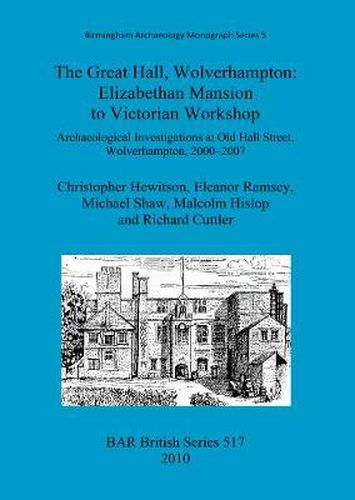Readings Newsletter
Become a Readings Member to make your shopping experience even easier.
Sign in or sign up for free!
You’re not far away from qualifying for FREE standard shipping within Australia
You’ve qualified for FREE standard shipping within Australia
The cart is loading…






This title is printed to order. This book may have been self-published. If so, we cannot guarantee the quality of the content. In the main most books will have gone through the editing process however some may not. We therefore suggest that you be aware of this before ordering this book. If in doubt check either the author or publisher’s details as we are unable to accept any returns unless they are faulty. Please contact us if you have any questions.
This report outlines the results of archaeological investigations at Old Hall Street, Wolverhampton, West Midlands, UK (NGR SO 916984), carried out between 2000 and 2007. The results of the archaeological work have been combined with documentary, cartographic and genealogical studies, together with finds and scientific analyses, to present a broad interpretation of the history of settlement in the area and the motives behind it. The site was the location of a moated Elizabethan mansion house, the Great Hall, which lay at the edge of the then settled area of Wolverhampton in an area that had once been part of the town fields. A documentary reference suggests that there was an earlier house on the site, but there is only limited archaeological evidence to support this. The building of the Great Hall was intended to make a clear statement about the status, wealth and prestige of its owners, the Leveson family, who were prominent Wolverhampton merchants, also involved in the early industrialisation of the Black Country. The aspirations of the family are clearly demonstrated by their construction of one of Staffordshire’s most significant early brick buildings The later history of the Great Hall mirrors that of the Black Country, for towards the end of the 18th century it was converted for use as a japanning factory, known as the Old Hall Works, artefacts from which were exhibited in the Great Exhibition of 1851. A large-scale map of 1852 gives a detailed insight into the layout of the japanning factory, which was finally demolished in 1883, an Adult Education College being built on the site in 1899. The archaeological excavations took place ahead of the redevelopment of the college. This report shows something of the process by which the Black Country attained its distinctive personality.
$9.00 standard shipping within Australia
FREE standard shipping within Australia for orders over $100.00
Express & International shipping calculated at checkout
This title is printed to order. This book may have been self-published. If so, we cannot guarantee the quality of the content. In the main most books will have gone through the editing process however some may not. We therefore suggest that you be aware of this before ordering this book. If in doubt check either the author or publisher’s details as we are unable to accept any returns unless they are faulty. Please contact us if you have any questions.
This report outlines the results of archaeological investigations at Old Hall Street, Wolverhampton, West Midlands, UK (NGR SO 916984), carried out between 2000 and 2007. The results of the archaeological work have been combined with documentary, cartographic and genealogical studies, together with finds and scientific analyses, to present a broad interpretation of the history of settlement in the area and the motives behind it. The site was the location of a moated Elizabethan mansion house, the Great Hall, which lay at the edge of the then settled area of Wolverhampton in an area that had once been part of the town fields. A documentary reference suggests that there was an earlier house on the site, but there is only limited archaeological evidence to support this. The building of the Great Hall was intended to make a clear statement about the status, wealth and prestige of its owners, the Leveson family, who were prominent Wolverhampton merchants, also involved in the early industrialisation of the Black Country. The aspirations of the family are clearly demonstrated by their construction of one of Staffordshire’s most significant early brick buildings The later history of the Great Hall mirrors that of the Black Country, for towards the end of the 18th century it was converted for use as a japanning factory, known as the Old Hall Works, artefacts from which were exhibited in the Great Exhibition of 1851. A large-scale map of 1852 gives a detailed insight into the layout of the japanning factory, which was finally demolished in 1883, an Adult Education College being built on the site in 1899. The archaeological excavations took place ahead of the redevelopment of the college. This report shows something of the process by which the Black Country attained its distinctive personality.